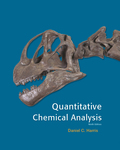
Concept explainers
a)
Interpretation:
The ionic strength of the buffer is
a)
Explanation of Solution
Given:
pH is
The change in buffer species when mixed with the acid
The ionic strength of the buffer is
b)
Interpretation:
The pH and
Concept Introduction:
Metal ion buffer:
A metal-ion buffer gives a controlled source of free metal ions in a way related to the regulation of hydrogen ion concentration by a pH buffer. A metal-ion buffer solution has the free (hydrated) metal ion along with a complex compound made by the association of the ion with a ligand in excess. The concentration of free metal ion mainly depends on the total concentration of each component (ligand and metal ion) and also on the stability constant of the complex. The concentration of the free metal ion depends upon on solution pH if the ligand can undergo protonation.
Concentration=
b)
Answer to Problem 15.29P
The pH and
Explanation of Solution
Given:
Concentration=
Given
Where pH=
Then,
Units will cancel each other since, both the numerator and denominator has concentrations.
The pH and
c)
Interpretation:
The needed molalities of
Concept Introduction:
Metal ion buffer:
A metal-ion buffer gives a controlled source of free metal ions in a way related to the regulation of hydrogen ion concentration by a pH buffer. A metal-ion buffer solution has the free (hydrated) metal ion along with a complex compound made by the association of the ion with a ligand in excess. The concentration of free metal ion mainly depends on the total concentration of each component (ligand and metal ion) and also on the stability constant of the complex. The concentration of the free metal ion depends upon on solution pH if the ligand can undergo protonation.
Concentration=
c)
Answer to Problem 15.29P
The needed molalities of
Explanation of Solution
The pH
In order maintain a constant ionic strength we must decrease
So increasing the
Given:
Concentration=
Given
So, the new concentration are
The needed molalities of
Want to see more full solutions like this?
Chapter 15 Solutions
Quantitative Chemical Analysis
 ChemistryChemistryISBN:9781305957404Author:Steven S. Zumdahl, Susan A. Zumdahl, Donald J. DeCostePublisher:Cengage Learning
ChemistryChemistryISBN:9781305957404Author:Steven S. Zumdahl, Susan A. Zumdahl, Donald J. DeCostePublisher:Cengage Learning ChemistryChemistryISBN:9781259911156Author:Raymond Chang Dr., Jason Overby ProfessorPublisher:McGraw-Hill Education
ChemistryChemistryISBN:9781259911156Author:Raymond Chang Dr., Jason Overby ProfessorPublisher:McGraw-Hill Education Principles of Instrumental AnalysisChemistryISBN:9781305577213Author:Douglas A. Skoog, F. James Holler, Stanley R. CrouchPublisher:Cengage Learning
Principles of Instrumental AnalysisChemistryISBN:9781305577213Author:Douglas A. Skoog, F. James Holler, Stanley R. CrouchPublisher:Cengage Learning Organic ChemistryChemistryISBN:9780078021558Author:Janice Gorzynski Smith Dr.Publisher:McGraw-Hill Education
Organic ChemistryChemistryISBN:9780078021558Author:Janice Gorzynski Smith Dr.Publisher:McGraw-Hill Education Chemistry: Principles and ReactionsChemistryISBN:9781305079373Author:William L. Masterton, Cecile N. HurleyPublisher:Cengage Learning
Chemistry: Principles and ReactionsChemistryISBN:9781305079373Author:William L. Masterton, Cecile N. HurleyPublisher:Cengage Learning Elementary Principles of Chemical Processes, Bind...ChemistryISBN:9781118431221Author:Richard M. Felder, Ronald W. Rousseau, Lisa G. BullardPublisher:WILEY
Elementary Principles of Chemical Processes, Bind...ChemistryISBN:9781118431221Author:Richard M. Felder, Ronald W. Rousseau, Lisa G. BullardPublisher:WILEY





